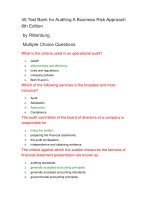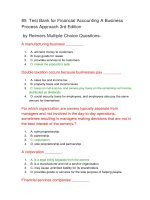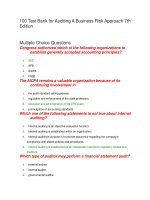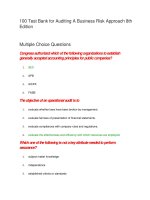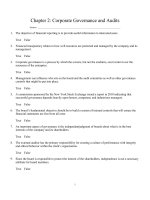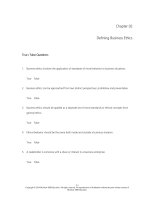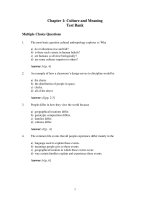Data communications and computer networks a business users approach 7th edition curt white test bank
Bạn đang xem bản rút gọn của tài liệu. Xem và tải ngay bản đầy đủ của tài liệu tại đây (160.11 KB, 12 trang )
Chapter 2: Fundamentals of Data and Signals
TRUE/FALSE
1. The terms “data” and “signal” mean the same thing.
ANS: F
PTS: 1
REF: 30
2. By convention, the minimum and maximum values of analog data and signals are presented as
voltages.
ANS: T
PTS: 1
REF: 32
3. One of the primary shortcomings of analog data and analog signals is how difficult it is to separate
noise from the original waveform.
ANS: T
PTS: 1
REF: 32
4. The ability to separate noise from a digital waveform is one of the great strengths of digital systems.
ANS: T
PTS: 1
REF: 32
5. A sine wave is common example used to demonstrate an analog signal.
ANS: T
PTS: 1
REF: 33
6. The period of a signal can be calculated by taking the reciprocal of the frequency (1/frequency).
ANS: T
PTS: 1
REF: 35
7. The telephone system transmits signals in the range of 150 Hz to 1500 Hz.
ANS: F
PTS: 1
REF: 36
8. Attenuation in a medium such as copper wire is a logarithmic loss and is a function of distance and the
resistance within the wire.
ANS: T
PTS: 1
REF: 37
9. Like signals, data can be analog or digital.
ANS: T
PTS: 1
REF: 39
10. Telephones, AM radio, FM radio, broadcast television, and cable television are the most common
examples of analog data-to-digital signal conversion.
ANS: F
PTS: 1
REF: 40
11. The NRZ-L encoding scheme is simple to generate and inexpensive to implement in hardware.
ANS: T
PTS: 1
REF: 41
12. With NRZI, the receiver has to check the voltage level for each bit to determine whether the bit is a 0
or a 1.
ANS: F
PTS: 1
REF: 41
13. With NRZ-L, the receiver has to check whether there is a change at the beginning of the bit to
determine if it is a 0 or a 1.
ANS: F
PTS: 1
REF: 42
14. An inherent problem with the NRZ-L and NRZI digital encoding schemes is that long sequences of 0s
in the data produce a signal that never changes.
ANS: T
PTS: 1
REF: 42
15. The big disadvantage of the Manchester schemes is that roughly half the time there will be two
transitions during each bit.
ANS: T
PTS: 1
REF: 42
16. Under some circumstances, the baud rate may equal the bps, such as in the Manchester encoding
schemes.
ANS: F
PTS: 1
REF: 43
17. Amplitude shift keying is restricted to only two possible amplitude levels: low and high.
ANS: F
PTS: 1
REF: 45
18. Amplitude shift keying is susceptible to sudden noise impulses such as the static charges created by a
lightning storm.
ANS: T
PTS: 1
REF: 46
19. Frequency shift keying is susceptible to sudden noise spikes that can cause loss of data.
ANS: F
PTS: 1
REF: 46
20. Phase changes are not affected by amplitude changes, nor are they affected by intermodulation
distortions.
ANS: T
PTS: 1
REF: 47
21. The bps of the data transmitted using quadrature amplitude modulation is four times the baud rate.
ANS: F
PTS: 1
REF: 47
22. According to a famous communications theorem created by Nyquist, the sampling rate using pulse
code modulation must be at least three times the highest frequency of the original analog waveform.
ANS: F
PTS: 1
REF: 51
23. One of the most common forms of data transmitted between a transmitter and a receiver is textual data.
ANS: T
PTS: 1
REF: 51
24. Certain control characters provide data transfer control between a computer source and computer
destination.
ANS: T
PTS: 1
REF: 53
25. IBM mainframe computers are major users of the EBCDIC character set.
ANS: T
PTS: 1
REF: 53
26. ASCII is a data code rarely used in the world.
ANS: F
PTS: 1
REF: 54
27. A byte consists of 8 bits.
ANS: T
PTS: 1
REF: 54
28. One of the major problems with Unicode is that it cannot represent symbols other than those found in
the English language.
ANS: F
PTS: 1
REF: 55
29. ASCII is one of the supported code charts in Unicode.
ANS: T
PTS: 1
REF: 55
30. In Unicode, the letter “r” is represented by the binary value of 0000 0000 0101 0100 0010.
ANS: F
PTS: 1
REF: 55
MULTIPLE CHOICE
1. ____ are entities that convey meaning within a computer or computer system.
a. Signals
c. Impulse
b. Data
d. EMI
ANS: B
PTS: 1
REF: 32
2. If you want to transfer data from one point to another, either via a physical wire or through radio
waves, the data has to be converted into a(n) ____.
a. hertz
c. signal
b. Unicode
d. byte
ANS: C
PTS: 1
REF: 32
3. ____ are represented as continuous waveforms that can be at an infinite number of points between
some given minimum and maximum.
a. Analog signals
c. Digital data
b. Digital signals
d. Digital pulses
ANS: A
PTS: 1
REF: 32
4. The most common example of ____ data is the human voice.
a. sampling
c. digital
b. baud
d. analog
ANS: D
PTS: 1
REF: 32
5. Unfortunately, noise itself occurs as a(n) ____ waveform, and this makes it challenging, if not
extremely difficult, to separate noise from an analog waveform that represents data.
a. analog
c. hertz
b. digital
d. byte
ANS: A
PTS: 1
REF: 33
6. ____ are discrete waveforms, rather than continuous waveforms.
a. Analog signals
c. Digital signals
b. Analog bauds
d. Analog data
ANS: C
PTS: 1
REF: 34
7. The three basic components of analog and digital signals are: amplitude, frequency, and ____.
a. cycles
c. hertz
b. baud
d. phase
ANS: D
PTS: 1
REF: 35
8. The amplitude of a signal can be expressed as volts, ____, or watts.
a. hertz
c. bits
b. amps
d. bytes
ANS: B
PTS: 1
REF: 35
9. The ____ of a signal is the number of times a signal makes a complete cycle within a given time
frame.
a. phase
c. period
b. amplitude
d. frequency
ANS: D
PTS: 1
REF: 35
10. Cycles per second, or frequency, is represented by ____.
a. bytes
c. bits
b. hertz
d. watts
ANS: B
PTS: 1
REF: 36
11. The frequency range of the average human voice usually goes no lower than 300 Hz and no higher
than approximately ____ Hz.
a. 2200
c. 3400
b. 2400
d. 5300
ANS: C
PTS: 1
REF: 36
12. The lowest note possible on the piano is ____ Hz, and the highest note possible is 4200 Hz.
a. 30
c. 300
b. 80
d. 450
ANS: A
PTS: 1
REF: 36
13. The bandwidth of a telephone system that transmits a single voice in the range of 300 Hz to 3400 Hz is
____ Hz.
a. 10
c. 3100
b. 100
d. 3700
ANS: C
PTS: 1
REF: 36
14. When traveling through any type of medium, a signal always experiences some loss of its power due
to friction. This loss of power, or loss of signal strength, is called ____.
a. amplification
c. decibel
b. friction
d. attenuation
ANS: D
PTS: 1
REF: 37
15. When a signal is amplified by an amplifier, the signal gains in ____.
a. decibels
c. bytes
b. hertz
d. watts
ANS: A
PTS: 1
REF: 37
16. ____ is the process of sending data over a signal by varying either its amplitude, frequency, or phase.
a. Amplification
c. Attenuation
b. Modulation
d. Digital encoding
ANS: B
PTS: 1
REF: 40
17. The ____ encoding scheme has a voltage change at the beginning of a 1 and no voltage change at the
beginning of a 0.
a. nonreturn to zero inverted (NRZI)
c. Manchester
b. nonreturn to zero-level (NRZ-L)
d. Differential Manchester
ANS: A
PTS: 1
REF: 41
18. The ____ digital encoding scheme is similar to the Manchester scheme in that there is always a
transition in the middle of the interval.
a. NRZ-L
c. differential Manchester
b. Bipolar-AMI
d. NRZI
ANS: C
PTS: 1
REF: 42
19. The Manchester encoding schemes are called ____, because the occurrence of a regular transition is
similar to seconds ticking on a clock.
a. continuous-clocking
c. discrete-clocking
b. analog-clocking
d. self-clocking
ANS: D
PTS: 1
REF: 42
20. The number of times a signal changes value per second is called the ____ rate.
a. hertz
c. watts
b. baud
d. volts
ANS: B
PTS: 1
21. The data rate is measured in ____.
a. bits per second (bps)
b. bytes per second (Bps)
REF: 43
c. bauds per second (bps)
d. hertz per second (hps)
ANS: A
PTS: 1
REF: 43
22. Using ____, when a device transmits a binary 0, a zero voltage is transmitted. When the device
transmits a binary 1, either a positive voltage or a negative voltage is transmitted.
a. Manchester
c. differential Manchester
b. bipolar-AMI
d. NRZ-L
ANS: B
PTS: 1
REF: 43
23. The primary advantage of a bipolar scheme is that when all the voltages are added together after a long
transmission, there should be a total voltage of ____.
a. -2
c. 0
b. -1
d. 1
ANS: C
PTS: 1
REF: 43
24. The Manchester encoding schemes solve the synchronization problem but are relatively inefficient
because they have a baud rate that is ____ the bps.
a. equal to
c. three times
b. twice
d. four times
ANS: B
PTS: 1
REF: 44
25. A device that modulates digital data onto an analog signal and then demodulates the analog signal
back to digital data is a ____.
a. repeater
c. hub
b. switch
d. modem
ANS: D
PTS: 1
REF: 45
26. Three currently popular modulation techniques for encoding digital data and transmitting it over
analog signals are amplitude shift keying, frequency shift keying, and ____ shift keying.
a. noise
c. strength
b. baud
d. phase
ANS: D
PTS: 1
REF: 45
27. The simplest modulation technique is ____ shift keying.
a. amplitude
c. frequency
b. phase
d. noise
ANS: A
PTS: 1
28. Frequency shift keying is subject to ____.
a. baud noise
b. bps distortion
ANS: C
PTS: 1
REF: 45
c. intermodulation distortion
d. noise spikes
REF: 46
29. ____ shift keying represents 0s and 1s by different changes in the phase of a waveform.
a. Amplitude
c. Frequency
b. Phase
d. Noise
ANS: B
PTS: 1
REF: 46
30. ____ shift keying incorporates four different phase angles, each of which represents 2 bits.
a. Quadrature amplitude
b. Quadrature frequency
ANS: D
PTS: 1
c. Quadrature noise
d. Quadrature phase
REF: 47
31. ____ modulation, which is commonly employed in contemporary modems, uses each signal change to
represent 4 bits.
a. Quadrature amplitude
c. Quadrature noise
b. Quadrature frequency
d. Quadrature phase
ANS: A
PTS: 1
REF: 47
32. One encoding technique that converts analog data to a digital signal is ____.
a. NRZ-L
c. pulse code modulation (PCM)
b. Manchester
d. NRZ-I
ANS: C
PTS: 1
REF: 48
33. Tracking an analog waveform and converting it to pulses that represent the wave’s height above (or
below) a threshold is termed ____.
a. pulse amplitude modulation (PAM)
c. quantization
b. codec
d. quantization levels
ANS: A
PTS: 1
REF: 48
34. When converting analog data to digital signals, the frequency at which the snapshots are taken is called
the ____ rate.
a. baud
c. bps
b. sampling
d. byte
ANS: B
PTS: 1
REF: 50
35. With ____, a codec tracks the incoming analog data by assessing up or down “steps.”
a. differential Manchester
c. NRZI
b. Bipolar-AMI
d. delta modulation
ANS: D
PTS: 1
REF: 51
36. Three important data codes are EBCDIC, ____, and Unicode.
a. NRZ-L
c. ASCII
b. 4B/5B
d. NRZI
ANS: C
PTS: 1
REF: 53
37. ____ is an 8-bit code allowing 256 possible combinations of textual symbols.
a. EBCDIC
c. NRZI
b. Unicode
d. UTF-9
ANS: A
PTS: 1
REF: 53
38. The ____ is a government standard in the United States.
a. UTF-8
b. EBCDIC
c. American Standard Code for Information Interchange (ASCII)
d. Unicode
ANS: C
PTS: 1
REF: 54
39. The ASCII character set exists in a few different forms, including a ____ version that allows for 128
possible combinations of textual symbols.
a. 3-bit
c. 6-bit
b. 5-bit
d. 7-bit
ANS: D
PTS: 1
REF: 54
40. The Unicode character set uses ______ bit characters.
a. 4
c. 16
b. 8
d. 32
ANS: C
PTS: 1
REF: 55
COMPLETION
1. Converting analog data to digital signals is generally called ____________________.
ANS: digitization
PTS: 1
REF: 31
2. ____________________ are the electric or electromagnetic impulses used to encode and transmit data.
ANS: Signals
PTS: 1
REF: 32
3. ____________________ is unwanted electrical or electromagnetic energy that degrades the quality of
signals and data.
ANS: Noise
PTS: 1
REF: 33
4. The ____________________ of a signal is the height of the wave above (or below) a given reference
point.
ANS: amplitude
PTS: 1
REF: 35
5. The ____________________, or time interval, of one cycle is called its period.
ANS: length
PTS: 1
REF: 35
6. The range of frequencies that a signal spans from minimum to maximum is called the
____________________.
ANS: spectrum
PTS: 1
REF: 36
7. The ____________________ of a signal is the absolute value of the difference between the lowest and
highest frequencies.
ANS: bandwidth
PTS: 1
REF: 36
8. Because extraneous noise degrades original signals, an electronic device usually has a(n)
____________________ that is less than its bandwidth.
ANS: effective bandwidth
PTS: 1
REF: 36
9. The ____________________ of a signal is the position of the waveform relative to a given moment of
time, or relative to time zero.
ANS: phase
PTS: 1
REF: 36
10. ____________________ is a relative measure of signal loss or gain and is used to measure the
logarithmic loss or gain of a signal.
ANS:
Decibel (dB)
Decibel
dB
PTS: 1
REF: 37
11. ____________________ is the opposite of attenuation.
ANS: Amplification
PTS: 1
REF: 37
12. The ____________________ digital encoding scheme transmits 1s as zero voltages and 0s as positive
voltages.
ANS:
nonreturn to zero-level (NRZ-L)
nonreturn to zero-level
NRZ-L
PTS: 1
REF: 41
13. With the ____________________ encoding scheme, to transmit a 1, the signal changes from low to
high in the middle of the interval; to transmit a 0, the signal changes from high to low in the middle of
the interval.
ANS: Manchester
PTS: 1
REF: 42
14. The ____________________ encoding scheme takes 4 bits of data, converts the 4 bits into a unique
5-bit sequence, and encodes the 5 bits using NRZI.
ANS: 4B/5B
PTS: 1
REF: 44
15. ____________________ is a simpler form of modulation in which binary 1s and 0s are represented by
uniquely different values of amplitude, frequency, or phase.
ANS: Shift keying
PTS: 1
REF: 45
16. ____________________ shift keying uses two different frequency ranges to represent data values of 0
and 1.
ANS: Frequency
PTS: 1
REF: 46
17. ____________________ is a phenomenon that occurs when the frequencies of two or more signals
mix together and create new frequencies.
ANS: Intermodulation distortion
PTS: 1
REF: 46
18. A(n) ____________________ converts the analog data to a digital signal by tracking the analog
waveform and taking “snapshots” of the analog data at fixed intervals.
ANS: codec
PTS: 1
REF: 48
19. Quantization error, or ____________________, causes the regenerated analog data to differ from the
original analog data.
ANS: quantization noise
PTS: 1
REF: 50
20. A problem inherent with delta modulation is that if the analog waveform rises or drops too quickly, the
codec may not be able to keep up with the change, and ____________________ results.
ANS: slope overload noise
PTS: 1
REF: 51
21. The set of all textual characters or symbols and their corresponding binary patterns is called a(n)
____________________.
ANS: data code
PTS: 1
REF: 51
22. The control character ____________________ (LF) provides control between a processor and an
input/output device.
ANS: linefeed
PTS: 1
REF: 53
23. The control character ____________________ (CR) provides control between a processor and an
input/output device.
ANS: carriage return
PTS: 1
REF: 53
24. ____________________ is an encoding technique that provides a unique coding value for every
character in every language, no matter what the platform.
ANS: Unicode
PTS: 1
REF: 55
25. Currently, ____________________ supports more than 110 different code charts (languages and
symbol sets).
ANS: Unicode
PTS: 1
REF: 55
ESSAY
1. What are the four possible data-to-signal conversion combinations?
ANS:
Data and signals are two of the basic building blocks of any computer network. It is important to
understand that the terms “data” and “signal” do not mean the same thing, and that in order for a
computer network to transmit data, the data must first be converted into the appropriate signals. The
one thing data and signals have in common is that both can be in either analog or digital form, which
gives us four possible data-to-signal conversion combinations:
* Analog data-to-analog signal, which involves amplitude and frequency modulation techniques
* Digital data-to-digital signal, which involves encoding techniques
* Digital data-to-discrete analog signal, which involves modulation techniques
* Analog data-to-digital signal, which involves digitization techniques
PTS: 1
REF: 30
2. What are common examples of data?
ANS:
Common examples of data include:
* A computer file of names and addresses stored on a hard disk drive
* The bits or individual elements of a movie stored on a DVD
* The binary 1s and 0s of music stored on a compact disc or inside an iPod
* The dots (pixels) of a photograph that has been digitized by a digital camera and stored on a memory
stick
* The digits 0 through 9, which might represent some kind of sales figures for a business
PTS: 1
REF: 31-32
3. What are common examples of signals?
ANS:
Common examples of signals include:
* A transmission of a telephone conversation over a telephone line
* A live television news interview from Europe transmitted over a satellite system
* A transmission of a term paper over the printer cable between a computer and a printer
* The downloading of a Web page as it transfers over the telephone line between your Internet service
provider and your home computer
PTS: 1
REF: 32
4. What happens when you introduce noise into digital data and digital signals?
ANS:
Noise has the properties of an analog waveform and thus can occupy an infinite range of values; digital
waveforms occupy only a finite range of values. When you combine analog noise with digital
waveform, it is fairly easy to separate the original digital waveform from the noise.
If the amount of noise remains low enough that the original digital waveform can still be interpreted,
then the noise can be filtered out, thereby leaving the original waveform. If, however, the noise
becomes so great that it is no longer possible to distinguish a high from a low, then the noise has taken
over the signal and you can no longer understand this portion of the waveform.
PTS: 1
REF: 33
5. What is the purpose of using digital encoding schemes?
ANS:
To transmit digital data using digital signals, the 1s and 0s of the digital data must be converted to the
proper physical form that can be transmitted over a wire or airwave. Thus, if you wish to transmit a
data value of 1, you could do this by transmitting a positive voltage on the medium. If you wish to
transmit a data value of 0, you could transmit a zero voltage. You could also use the opposite scheme:
a data value of 0 is positive voltage, and a data value of 1 is a zero voltage. Digital encoding schemes
like this are used to convert the 0s and 1s of digital data into the appropriate transmission form. There
are six digital encoding schemes that are representative of most digital encoding schemes: NRZ-L,
NRZI, Manchester, differential Manchester, bipolar-AMI, and 4B/5B.
PTS: 1
REF: 40-41

